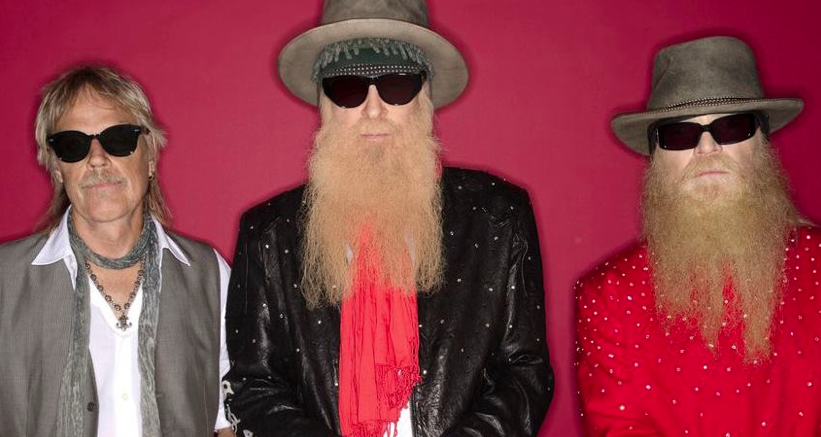Dear Guitar Hero: ZZ Top's Billy Gibbons Talks Pinch Harmonics, Gear, Setup, Strings and More

From the GW archive: This feature originally appeared in the May 2005 issue of Guitar World.
He's been known to play guitar through a pack of cigarettes and his wooly mammoth tone-and facial hair-have inspired guitarists for decades. But what Guitar World readers really want to know is...
Why did you start using a peso as a pick? — Paul Shuffield, Jr.
Tommy Carter of Jimmie Vaughan's Dallas band the Chessmen used a quarter to play bass. He described the serrated edge of the coin as producing a delightful scratchiness as he scrubbed the strings. That gave me the idea, and our love of the Mexican border is what drew us to the peso. The peso coin is a rarity, but we've still got a few filed down for the ready.
Does the fur affect your beloved tone? — Chris Tracyr
The fur on the guitar or my face?
You use six Bixonic Expandora pedals for distortion, which would seem to create a muddy mess. Do you set the levels differently on each one to create the desired sustain while maintaining a cleaner distortion sound? Please help. Not knowing makes my medication less effective. — Kevin Potts
All the latest guitar news, interviews, lessons, reviews, deals and more, direct to your inbox!
You are correct. Combinations of multiple effects are manageable when using a slight edge from each, which avoids the unwanted collision of tones. However, at this point, sometimes the grind of excessive noise becomes its own thing! Experiment...just not with your medication.
Do you really use .008 gauge strings? If so, how do you keep them from flapping when detuning? And how do you get such a great tone, since I have always believed the bigger the strings, the better the tone? — Brian Wachter
I, too, once believed in the heavier gauge string as a superior tone source. However, thanks to the graciousness of B.B. King I learned that a lighter gauge string offers superior playing comfort. Detuning requires some adjustment of attack, approach and feel. Try it. You may like it.
Where can I get one of those pimp-ass hats? — Garen Henry
From a Bamileke tribal member in Cameroon, West Africa. Be sure to take a Texas 10-gallon along for good trading.
Please tell me about your fantastic-sounding Pearly Gates. Was it love at first sight, and how and why does it sound so damn good? — Peter Ohmer
She is a 1959, and I acquired her when I was 18. While I have always been in love with her, I would have to say it was luck, not love, at first sight. We've studied the varying construction techniques used on a wide range of Les Pauls, and Pearly Gates seems simply to have been on the assembly line on the right day at the right time. It was the right glue, the right wood, the right finish on the right day. It's just all good.
I apologize if my question causes you nightmares, but if you had to choose between blowing up all of your custom hot rods and chopping up all of your guitars and amps with an ax, which would you do? — Dallas Tringali
Oh my God! We'd probably prefer to take a quick cruise and play each guitar, and burn the whole house down!
Did Frank play drums on Eliminator and did you play any guitar synth on the album? — AC Johnson
Frank played his trusty acoustic kit and used triggers to activate sounds on his drum modules. Although a guitar synth was present, we focused our attention on one of Mr. Moog's keyboard contraptions.
Ever jam with Johnny Winter when you were both young Texas bucks? — Michael Mosley
I was fortunate enough to join the legion of Johnny Winter fans when he first launched the great Johnny Winter trio [with bassist Tommy Shannon and drummer Uncle John Turner]. We were content to remain in awe and admiration without attempting to crowd the stage.
What was your gear setup for Rhythmeen? I'm interested in how you obtained such a great low-end growl for that album. — Steve
That was the fine work of a detuned '55 Goldtop running through a modified Marshall 100, in conjunction with Marshall's JMP-1 preamp. The two amp sources working together created a curious organic delaylike effect that we still use in our studio today.
As a fan of ZZ Top and Queens of the Stone Age, I am wondering how you ended up appearing on Queens' new Lullabies to Paralyze album, how you felt about the experience and what gear you used. — St. Jimmy
The invitation to work with Josh Homme and company came by way of a phone call to our on-road production office. At the insistence of our road crew, I engaged in a studio session and had an absolute blast. Those guys are quite creative. They're willing to go out and try things. They had so much great gear in there that I really cannot relate what I ended up using, but they had an incredible array of choice-sounding guitars, amps and effects, both vintage and current. I just showed up and started trying out gear, having a blast. Hard to say what ended up on the tracks.
You are the king of artificial harmonics. How do you hit them so smoothly and exactly? — Matt Bush
Quite simply: it's meat on metal on wood. Roll the picking fingers slightly off edge of the plectrum and move around a bit. The sound changes drastically and requires some experimentation until you get comfortable finding your sweet spots.
You are well known for your pinch harmonics. What boggles my mind is how you do harmony between the pitches on the same fret. I'm thinking of "La Grange." How do you know each note's pitch and harmonize them perfectly? — Josh Berry
See the answer to the question above. It's a tricky thing to do, until muscle memory becomes second nature. Striking exactly where you want to requires some guesswork, especially while you are learning the technique. Again, experiment until you're playing what you want to hear.
I love the way it sounds like two guitar players dueling back and forth on Deguello and would like to confirm what I know but still find hard to grasp: that is all you, right? — Russell d Lancaster
Correct. The magic of multitracking turned our trio into a multipiece combo. Having to do it all simply requires the virtue of patience.
Why don't you use Marshall amps onstage anymore? — Scott Cronn
Marshalls are still present in our lineup and remain the cornerstone for our guitar and bass tones, though their presence may not be as visually apparent. We're using the Marshall tube preamp and loading that into Marshall's now out-of-production 120/120 power amp.
You had a keyboard player on the first ZZ album. How did the group decide to become a three-piece? What are your likes and dislikes about playing in a trio? — Brian Birckbichler
Our first recording did feature ZZ top as a trio, but instead of using guitar, drums and bass, we used guitar, drums and a Hammond B-3 organ. [ZZ Top's first single, "Salt Lick" b/w "Miller's Farm," features this lineup. The tracks are available on the Chrome, Smoke & BBQ box set (Rhino)]. The power of the kick [bass] pedals from the keyboard allowed us to create a four-piece sound with the minimalism of a trio, which is what we have always loved. Presently, ZZ Top enjoys the challenge that trio performance requires. Quite lively.
Have you always been a sharp-dressed man? I saw some old photos of you guys in cheesy blue cowboy suits, which stopped me in my tracks. — Ryan Jones
To borrow Dusty's expression, we're immune to fashion. Thank goodness for the notion that accompanies the vision of sharp-dressed man. We're still trying to figure that one out.
You have always had fabulous tone. What amps and guitars did you use on ZZ Top's first few albums? — Rick Paulus
Thanks very much. We have been fortunate to enjoy the luxury of a spot-on crew, and we've maintained an archive of each instrument, amp, drum kit and ancillary devices used on each track. It's all on record, and any piece of gear can be lifted from the vault for most particular sounds. At the heart of almost everything we've done, however, is Pearly Gates run through either a Marshall or an old Fender. That simple-but-deadly combination is still tough to beat.
Brad is a Brooklyn-based writer, editor and video producer. He is the former content director of Revolver magazine and executive editor of Guitar World. His work has appeared in Vice, Guitar Aficionado, Inked and more. He’s also a die-hard Les Paul player who wishes he never sold his 1987 Marshall Silver Jubilee half stack.

